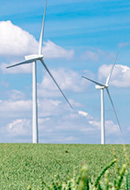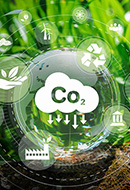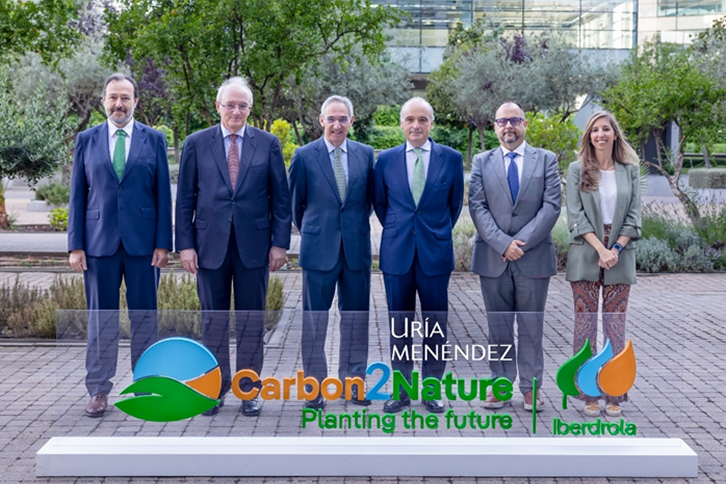Carbon markets
How are emission allowances and carbon credits markets regulated?
Carbon markets are internationally widespread economic instruments to encourage the reduction of greenhouse gas (GHG) emissions, such as CO₂, by the different sectors of productive activity. In these, the unit traded is equivalent to one tonne of carbon equivalent (tCO₂e), with two main types: regulated markets in which emission allowances are traded and voluntary markets in which carbon credits are traded, representing voluntary carbon reductions or removals. These instruments are expanding and are presented as an essential component of climate policy to stimulate climate change mitigation in different economies, helping to make the transition to net zero emissions more efficient.
Governments and international organisations around the world agree that global greenhouse gas (GHG) emissions must be drastically reduced to curb global warming. But how can this decarbonisation effort be carried out efficiently, sustainably and quickly when each sector and region starts from a different point of carbon dependency? This is where carbon markets come into play. They provide an economic signal to emitters and help mobilise the investments needed to stimulate low-carbon technological development and innovation, driving new engines of economic growth.
Carbon markets: regulated and voluntary
There are two types of carbon markets that function in a complementary manner: mandatory regulated markets and voluntary markets. These two types are very different: their only similarity is the underlying traded instrument, which is a tonne of carbon equivalent (tCO₂e), with significant divergences in their objectives and functioning.
 Regulated carbon market (ETS)
Regulated carbon market (ETS)
Such markets impose an obligation to pay for emitting. Also called emissions trading systems (ETS), companies trade "allowances" that allow the holder to emit one tonne of CO₂e. A central authority, usually a government - regional, national or supranational - determines an absolute cap or limit on emissions within the ETS and allowances are distributed among the covered business sectors, usually for free or through auctioning, for the amount of emissions equivalent to the cap.
Regulated entities must surrender allowances for an amount equivalent to the emissions they generate, with a choice between implementing internal reduction measures or purchasing allowances on the carbon market, depending on the relative costs of these options. By creating supply and demand for allowances, an ETS establishes a market price for emissions that fluctuates over time. In this way, an economic signal is generated and emissions reductions are incentivised to take place where they are most cost-effective. In addition, these systems are also a source of public revenue, helping to channel funding for the energy transition.
The purchase and sale of GHG emission rights is currently an essential axis for accelerating the decarbonisation of the global economy and a tool that, if properly regulated, has proven to be effective in promoting climate action in large companies and institutions. Putting a price on carbon emissions serves as an incentive to make investment in clean energy more attractive, both public and private, and as a way of rewarding the most environmentally sustainable business choices.
En ese tipo de mercados se impone una obligación de pagar por emitir. También llamados sistemas de comercio de emisiones (ETS por sus siglas en inglés), las empresas negocian “derechos de emisión” que permiten a su titular emitir una tonelada de CO₂e. Una autoridad central, normalmente un gobierno –regional, nacional o supranacional–, determina un tope o límite absoluto a las emisiones dentro del ETS y los derechos de emisión se distribuyen entre los sectores de actividad cubiertos, normalmente de forma gratuita o mediante subastas, por la cantidad de emisiones equivalente al tope.
The first ETS was established by the European Union in 2005 (EU ETS) and has since expanded. Currently, there are 34 ETSs  in jurisdictions representing more than 55% of global GDP and one third of the population and covering 17% of global annual emissions. Among others, they have been implemented in countries such as the UK, China, New Zealand, South Korea, Indonesia, California and Canada, and are under development or under consideration in other countries such as Brazil, Vietnam and Colombia.
in jurisdictions representing more than 55% of global GDP and one third of the population and covering 17% of global annual emissions. Among others, they have been implemented in countries such as the UK, China, New Zealand, South Korea, Indonesia, California and Canada, and are under development or under consideration in other countries such as Brazil, Vietnam and Colombia.
Currently, the largest system by market value and proceeds is the EU ETS with more than $36 billion raised by the end of 2021. By volume of emissions, the largest scheme is the Chinese ETS with approximately 4.5GtCO₂ (30% of China's emissions and 55% of all emissions covered by ETSs).
 Voluntary market
Voluntary market
Voluntary carbon markets, as their name suggests, respond to a particular and voluntary choice of governments, companies or individuals who can sell or purchase what are known as "carbon credits". It is a transferable instrument, certified by governments or private entities, which represents a tonne of carbon dioxide equivalent (tCO2 e) that a project either avoids/reduces against a baseline - such as preventing deforestation, promoting renewable energies and energy efficiency - or absorbs from the atmosphere - through reforestation (natural sinks) and carbon capture and storage activities (technological sinks).
The buyer of a credit can "retire" it from the market to reclaim the underlying performance towards the achievement of their own climate targets. It therefore allows companies to offset or neutralise their carbon footprint, as part of ambitious reduction strategies aligned with science.
For a project to generate credits, it must be certified to a recognised standard to ensure its quality and avoid double counting. Once issued, they may pass through several intermediaries before they are finally withdrawn from the market by the final purchaser. Unlike regulated markets (ETS), which trade allowances with identical prices and contractual aspects, credits can be highly variable in terms of project type, location, co-benefits and other factors, so buyers must perform due diligence to ensure that credits meet high quality standards.
Although the voluntary carbon market has been in operation for several decades, it has experienced significant growth in recent years. In terms of volume, in the period 2019-2021 the emission of credits has increased by 116% and demand for them by 130%, mainly driven by ambitious decarbonisation targets.
The largest regulated market for emission
The European Union Emissions Trading Scheme (EU ETS ) was born in 2005 as the first major carbon market in the world and remains today the one with the highest market value, affecting External link, opens in new window.. The EU ETS is therefore the best example of a regulated market, highlighting:
) was born in 2005 as the first major carbon market in the world and remains today the one with the highest market value, affecting External link, opens in new window.. The EU ETS is therefore the best example of a regulated market, highlighting:

It covers around 40% of the EU's total CO₂ and other GHG emissions from the power sector, part of industry and intra-EU aviation (including routes to the UK and Switzerland). In 2022 it reached an agreement to extend the scope of this market to the maritime sector as well.

It sets a cap on the number of total emissions allowed per year for the sectors covered among the 27 member states. In order to achieve the target set in the Green Pact and the EU Climate Law to reduce GHG emissions by 55% by 2030 (vs. 1990), thus meeting the climate change targets signed in the Paris Agreement, the EU ETS has been strengthened by increasing the target to reduce emissions in the covered sectors to 62% by 2030 vs. 2005 (from 42% previously). Allowable emissions will thus be reduced annually until only the amount that corresponds to the new ETS target can be emitted by 2030.
 The EU gives a free allocation of allowances to certain sectors to help their competitiveness. In particular, the free allocation to industrial sectors at risk of carbon leakage(1) is 100% of the allowances they need to cover their emissions and, until 2025, 30% to industrial sectors not at risk of carbon leakage. The market reform foresees the gradual phasing out of free allocation for some of the sectors at risk of carbon leakage (until its disappearance in 2034), through the implementation of a Border Carbon Adjustment Mechanism that will impose a carbon price on imports into the EU by equalising the cost of emissions for certain European and imported products, and for sectors without risk of leakage until reaching 0% in 2030. Finally, although the intra-European aviation sector receives part of the allowances it needs for free, it will be phased out gradually until it disappears from 2026.
The EU gives a free allocation of allowances to certain sectors to help their competitiveness. In particular, the free allocation to industrial sectors at risk of carbon leakage(1) is 100% of the allowances they need to cover their emissions and, until 2025, 30% to industrial sectors not at risk of carbon leakage. The market reform foresees the gradual phasing out of free allocation for some of the sectors at risk of carbon leakage (until its disappearance in 2034), through the implementation of a Border Carbon Adjustment Mechanism that will impose a carbon price on imports into the EU by equalising the cost of emissions for certain European and imported products, and for sectors without risk of leakage until reaching 0% in 2030. Finally, although the intra-European aviation sector receives part of the allowances it needs for free, it will be phased out gradually until it disappears from 2026.

The EU allocates among countries (based on historical emissions) a number of allowances to be auctioned for purchase by operators with and without obligations in the EU ETS. In the case of operators with obligations, they will buy the allowances needed to meet their annual obligations. Following the reform, Member States must use 100% of the proceeds from these auctions for purposes related to the climate objectives of this market, including the deployment of renewable energy.

On the other hand, the reform of the EU ETS Directive has included the creation in 2027 (or 2028) of a new EU ETS 2 separate from the first one to introduce GHG costing for suppliers of fossil fuels used in transport, buildings and industrial heat.
The EU ETS is a key element of the EU's climate policy and its key tool to cost-effectively reduce greenhouse gas emissions. Since its inception, EU emissions have decreased by 41%, promoting emission reductions in key sectors for decarbonisation such as power generation and heavy industry. As the world's largest mandatory carbon market, it is also a benchmark for global climate policy.
What is the carbon price of different markets?
In regulated markets, the price of carbon allowances varies depending on the market in which it is traded and the timing, which is driven by supply and demand. The auction price of allowances is not fixed, but it must be robust and predictable for the actors within the sector, and it must increase more or less steadily as a rule so that polluting becomes more expensive.
The following graph shows the evolution of the price of emission allowances in various ETS systems, where a progressive increase in prices since the pandemic can be seen in several systems. The highest prices correspond to the EU ETS, where at the end of 2022 prices reached more than 90 euros for a tonne of CO₂, following a recovery since the Covid-19 pandemic in 2020, when this price dropped to 20 euros.
Evolution of the price of emission allowances in different markets
Data (in euros) obtained from Allowance Price Explorer | International Carbon Action Partnership External link, opens in new window.
External link, opens in new window.
The price of carbon credits on the voluntary market varies considerably depending on the type of project, its age, the size of the transaction and the standard to which it is accredited(2). There are several platforms that offer CO credits2 from various developers with quality criteria and claimants can buy them at a price that is set.
Prices can range from less than $1/tCO2e for older projects with less verifiable co-benefits and lower quality, to more than $20/tCO2e for projects with unique characteristics and specific co-benefits (e.g., biodiversity). According to TROVE Research data, average prices in 2022 were around $8/tonne (volume-weighted average) although these prices are expected to increase as demand increases, lower cost options are exhausted and quality and co-benefit requirements increase.
(1) Carbon leakage is when a company decides to relocate its operations to regions with less restrictive climate policies and lower associated emission costs. To combat carbon leakage, special policies such as free allocation of emission allowances are applied for electro-intensive sectors with high emission costs and high international competition, such as steel, steel production, the chemical industry and the paper industry, among others.
(2) The price of a credit in the VCM is fixed per project and disclosure of the price paid is currently optional, as many transactions take place in the OTC market. With over 200 project types, price transparency is one of the biggest challenges in VCM today. However, this is improving with the emergence of more standardised platforms and products in spot and futures markets.

Decarbonisation
Regulatory principles and actions to fight climate change.

Carbon neutrality
What is it and why is it vital for the future of the planet?

Carbon footprint
What is the carbon footprint and why will reducing it help to combat climate change?

Greenhouse gas report
We calculate our carbon footprint since 2008.








